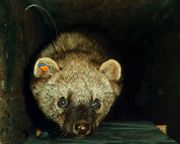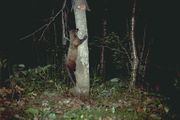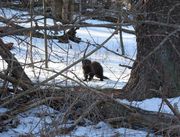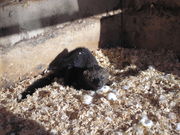Fisher (animal)
| Fisher | |
|---|---|
.jpg) |
|
| Conservation status | |
| Scientific classification | |
| Kingdom: | Animalia |
| Phylum: | Chordata |
| Class: | Mammalia |
| Order: | Carnivora |
| Family: | Mustelidae |
| Genus: | Martes |
| Species: | M. pennanti |
| Binomial name | |
| Martes pennanti (Erxleben, 1777) |
|
 |
|
| Range map[2] | |
The fisher (Martes pennanti), also referred to as fisher cat, is a medium-sized mammal native to North America. It is closely related to but larger than the American Marten (Martes americana). Names derived from aboriginal languages include pekan, pequam, and wejack. The fisher is a forest-dwelling creature whose range covers much of the boreal forest in Canada to the northern fringes of the United States.[3]
Males and females are similar in appearance but the males are larger in size. Males are between 90 to 120 centimetres (35–47 in) in length and weigh between 3.5 to 5 kilograms (8–11 lb). Females measure 75 to 95 centimetres (30–37 in) and weigh between 2 to 2.5 kilograms (4–6 lb).[4] The fur of the fisher varies seasonally with fur being denser and glossier in the winter. During the summer the colors become more mottled as the fur goes through a molting cycle. Fishers prefer to hunt in full forest. While they are agile climbers most of their time is spent on the forest floor. They also prefer to forage where there is a lot of fallen dead wood on the forest floor. Fishers are omnivorous and will feed on a wide variety of small animals and occasionally fruits and mushrooms. They show a preference for Snowshoe Hare and are one of the few predators that can successfully hunt porcupine.[5] Despite their name, fishers seldom eat fish.
The reproductive cycle of the fisher lasts almost the entire year. Female fishers give birth to a litter of 3-4 kits in the spring. They nurse and care for their kits up until late summer when they are old enough to set out on their own. Shortly after giving birth, females enter estrus and leave their den to find a mate. Implantation of the blastocyst is delayed until the following spring when they give birth and the cycle is renewed.[6]
Fishers have few predators except for man. Fishers have been trapped since the 18th century for their fur. Their pelts were in such demand that they were driven to near extinction in the early part of the 20th century. Conservation and protection measures have allowed the species to rebound but their current range is still reduced from its historic limits. In the 1920s when pelt prices were high, some fur farmers attempted to raise fishers. However, their unusual delayed reproduction made breeding difficult. When pelt prices fell in the late 1940s most fisher farming ended. While fishers are usually shy and elusive, urban encroachments into their forest habitat has placed them in uncomfortable proximity to human habitation. In recent years there have been several reports of fishers attacking small dogs and cats and in at least one case, a small child.[7]
Contents |
Etymology
The name implies a diet of fish yet it seldom dines on aquatic organisms. Early Dutch settlers noted its similarity to the European polecat (Mustela putorius). Fitchet is a name derived from the Dutch word visse which means 'nasty'. In the French language, the pelt of a polecat is called fiche or fichet.[8]
In some regions the fisher is known as a pekan, derived from its name in the Abenaki language. Wejack was derived from otchoek (Cree) and otochilik (Ojibwa) by fur traders. Other American Indian names for the fisher are tha cho (Chippewayan), meaning "big marten", and uskool (Wabanaki).[8]
Taxonomy
The Latin species name pennanti is named for Thomas Pennant who described the fisher in 1771. Buffon had first described the creature in 1765, calling it a pekan. Pennant examined the same specimen but called it a fisher apparently unaware of Buffon's earlier description. It wasn't until about 80 years later that Audubon determined that the two descriptions were in fact the same creature but he incorrectly placed it in the genus of Mustela. The fisher was eventually placed in the correct genus by E.M. Hagmeier in 1959.[9]
Members of the genus Martes are distinguished by having four premolar teeth on the upper and lower jaws. Its close relative Mustela has only three.[10] The fisher has 38 teeth. The dentition formula is:
| Dentition |
|---|
| 3.1.4.1 |
| 3.1.4.2 |
Evolution
There is evidence that ancestors of the fisher migrated to North America during the Pliocene era between 2.5 - 5 million years ago. Two extinct mustelids M. palaeosinensis and M. anderssoni have been found in eastern Asia. The first true fisher, M. divuliana has only been found in North America. There are strong indications that M. divuliana is related to the Asian finds which suggests a migration. M. Pennanti has been found as early as the Late Pleistocene era about 125,000 years ago. There are no major differences between the Pleistocene fisher and the modern fisher. Fossil evidence indicates that the fisher's range extended further south than it does today.[8]
Three subspecies were identified by Goldman in 1935, M.p. columbiana, M.p. pacifica, and M.p. pennanti. Later research has debated whether these subspecies could be positively identified. In 1959 E.M. Hagmeier concluded that the subspecies were not separable based on either fur or skull characteristics. Although some debate still exists, it is generally recognized that the fisher is a monotypic genus with no extant subspecies.[11]
Description

Fishers are a medium-size mammal. Their bodies are long, thin, and low to the ground. In appearance the sexes are hard to distinguish but they are sexually dimorphic in size with the male being larger than the female. Males are between 90 to 120 centimetres (35–47 in) in length and weigh between 3.5 to 5 kilograms (8–11 lb). Females measure 75 to 95 centimetres (30–37 in) and weigh between 2 to 2.5 kilograms (4–6 lb).[4] The largest ever male fisher recorded weighed 9 kilograms (20 lb).[12]
The fisher's fur changes with the season and differs slightly between sexes. Males have coarser coats than females. In the early winter the coats are dense and glossy ranging from 30 millimetres (1 in) on the chest to 70 millimetres (3 in) on the back. The color ranges from deep brown to black although it appears to be much blacker in the winter when contrasted with white snow. From the face to the shoulders fur can be hoary gold or silver due to tricolored guard hairs. The underside of a fisher is almost completely brown except for randomly placed patches of white- or cream-colored fur. In the summer, the fur color is more variable and may lighten considerably. Fishers undergo molting starting in late summer and finishing by November or December.[13]
Fishers have five toes on each foot with unsheathed, retractable claws. Their feet are disproportionately larger than their legs which makes it easier for them to move on top of snow packs. In addition to the toes, there are four central pads on each foot. On the hind paws there are coarse hairs that grow between the pads and the toes which gives them added traction when walking on a variety of surfaces.[14] Fishers have extremely mobile ankle joints which can rotate their hind paws almost 180 degrees allowing them to agilely move through tree branches and climb down trees head first.[15]
A circular patch of hair on the central pad of their hind paws marks plantar glands that give off a distinctive odor. Since these patches become enlarged during breeding season there is speculation that they are used for communication for reproduction.[14]
Behavior

Fishers are generally crepuscular. They are most active during dawn and dusk hours of the day. They are active year-round. Fishers are solitary, only associating with other fishers for mating purposes. Males become more active during mating season. Females are least active during pregnancy and gradually increase activity after birth of their kits.[6]
Hunting and diet
Fishers are generalist predators. They will feed on any animal they can catch and will eat carrion. They are also known to supplement their meat diet with insects, nuts, berries, and mushrooms. Their primary prey includes snowshoe hare and porcupine. Since they are solitary hunters their choice of prey is limited to their size. Analyses of stomach contents and scat have found evidence of birds, small mammals and even moose and deer. The latter food sources shows that they are not averse to eating carrion. Fishers have been observed to feed on the carcasses of deer left by hunters.[16]
Fishers are one of the few predators that seek out and kill porcupines. There are stories in popular literature that fishers can flip a porcupine onto its back and "scoop out its belly like a ripe melon."[17] As early as 1966, this was identified as an exaggerated myth.[18] However, observational studies show that fishers will make repeated biting attacks on the face of a porcupine and kill it after about 25–30 minutes.[5]
Reproduction
The reproductive cycle of the fisher is an almost year round cycle. Female fishers begin to breed at about one year of age. Breeding takes place in late March to early April. Blastocyst implantation is then delayed for 10 months until mid-February of the following year when active pregnancy begins. After gestating for about 50 days, the female gives birth to one to six kits. The female then enters estrus 7–10 days later and the breeding cycle begins again.[19]
Females den in hollow trees. Kits are born blind and helpless. They are partially covered with fine hair. Kits begin to crawl after about 3 weeks. After about 7 weeks they open their eyes. They start to climb after 8 weeks. Kits are completely dependent on their mother's milk for the first 8–10 weeks after which they begin to switch to a solid diet. After 4 months kits become intolerant of their litter mates and at 5 months the mother pushes them out on their own. After one year, juveniles will have established their own range.[6]
Range
Habitat

Although fishers are competent tree climbers they spend most of their time on the forest floor. They prefer conifer dominated forests especially in Western North America but are known to inhabit mixed wood deciduous forests as well. One of the factors that fishers select for are forest floors that are occupied by coarse woody debris. In western forests where fire regularly removes understorey debris, fishers show a preference for riparian woodland habitat.[20][21][22] They prefer closed canopy forests and avoid open spaces.
Distribution
Fishers are widespread throughout the northern forests of North America. They are found from Nova Scotia in the east to the Pacific shore of British Columbia. They can be found as far north as Great Slave Lake in the North West Territories and as far south as the mountains of Oregon. There are isolated populations in the Sierra Nevada of California and the Appalachians of West Virginia.[3] They were once more widespread in the United States Midwest but over trapping and loss of habitat has reduced their traditional range.
In recent years, they have spread from Vermont into southern New Hampshire, Massachusetts, and Rhode Island, and have recently been reintroduced into dozens of areas across the United States, including in Montana, Oregon, and Washington. As of 2009, reports indicate the fisher population has returned to areas from which they were previously extirpated, such as Connecticut, the Hudson Valley in New York, and New Jersey. The fisher has been seen in Alaska since the 1990s.
There are scattered fisher populations at present in the Rocky Mountains, mostly the result of reintroductions. In January 2008 fishers were reintroduced into the Olympic National Park in Washington State. Fishers, native to Washington, have not been known to exist anywhere in the state for generations because of overtrapping in the 1800s and early 1900s and the loss of old-growth forests.[23]
Recent studies, as well as anecdotal evidence, suggest that fishers have begun making inroads into suburban backyards, farmland, and even semi-urban areas in Michigan, Pennsylvania and central Massachusetts [24] as well as Ontario and Quebec in Canada.
Fishers and people
Fishers have had a long history of contact with humans. Most of the contact has been to the detriment of fisher populations. Driven to near extinction due to excessive trapping in the early 20th century, populations have since recovered sufficiently that the species is no longer endangered. Increasing forest cover in eastern North America means that fisher populations will remain sufficiently robust for the near future.
Fur trade and conservation
Fishers have been trapped since the 19th century. They have been popular with trappers due to the value of their fur. Their fur has been used for scarfs and neck pieces. The best pelts are from winter trapping with secondary quality pelts from spring trapping. The lowest quality furs come from out of season trapping when fishers are moulting.[25] They are easily trapped and the value of their fur was a particular incentive for catching this species. Prices for pelts have varied considerably over the past 100 years. Prices were highest in the 1920s and 1930s when average prices were about $100 US.[26] In 1936 pelts were being offered for sale in New York City for $450–750 per pelt.[27] Prices declined through the 1960s but picked up again in the late 1970s. In 1979, the Hudson's Bay Company paid $410 for one female pelt. In 1999 statistics showed that 16,638 pelts were sold in Canada for $449,307 (CAN) at an average price of $27.[28]
Between 1800 and 1940 fishers were threatened with near extinction in much of their range due to over trapping and alterations to their habitat. In New England, fishers, along with most other furbearers, were nearly exterminated due to unregulated trapping until the mid-1800s. Much of the forest habitat preferred by the fisher was put to agricultural use. Limited protection was afforded in the early 1900s, but it was not until 1934 that total protection was finally given to the few remaining fishers. Closed seasons, habitat recovery and reintroductions have restored fishers to much of the original range.
The fisher was again abundant enough in 1962 to warrant an open trapping season. During the early 1970s the value of fisher pelts soared, leading to another population crash in 1976. After a couple of years of closed seasons fisher trapping re-opened in 1979 with a shortened season and restricted bag limits. The population has steadily increased since then, with trappers taking about a thousand fishers per year in the late 1990s, despite a much lower pelt value.
Fishers were reintroduced into several states including Pennsylvania, Connecticut and West Virginia after being nearly wiped out by trapping and habitat destruction. Some reintroductions have been done to control porcupine populations. In May 2009, fisher pups were reported to have been born in a remote section of Olympic National Park in Washington State, a region where fishers were extirpated by the early 1900s. Reintroduction was started there in January 2008.[29]
Captivity
Fishers have been captured live for fur farming, zoo specimens, and scientific research. From 1920-1946 pelt prices averaged about $137 CAN. Since pelts were relatively valuable attempts were made to raise fishers on farms. Fur farming was popular with other species such as mink and ermine so it was thought that the same techniques could be applied to fishers. However, farmers found it difficult to raise fishers due to their unusual reproductive cycle. Knowledge of delayed implantation in fishers was generally unknown at the time. Farmers noted that females mated in the spring but did not give birth.[30] Due to declining pelt prices, most fisher farms closed operations by the late 1940s.
Fishers have also been captured and bred by zoos but they are not a common zoo species. Fishers are poor animals to exhibit because they generally hide from visitors all day. Some zoos have had difficulty keeping fishers alive since they are susceptible to many diseases in captivity.[31] Yet there is at least one example of a fisher kept in captivity that lived to be ten years old, well beyond its natural life span.[32]
In 1974, R.A. Powell raised two fisher kits for the purpose of performing scientific research. His primary interest was an attempt to measure the activity of fishers in order to determine how much food the animals required to function. He did this by running them through treadmill exercises which simulated activity in the wild. He compared this to their food intake and used the data to estimate daily food requirements. The research lasted for two years. After one year, one of the fishers died due to unknown causes. The second was released back into the wilderness of the Upper Michigan peninsula.[33]
Conflicts

In some areas fishers can become pests to farmers because they will get into a pen and kill large numbers of chickens. Unprovoked attacks on humans are extremely rare,[7] but they will attack if they feel threatened or cornered. There have been a few instances of fishers preying on cats and small dogs.[34][35][36][37][38][39][40] A study done in 1979 examined the stomach contents of all fishers trapped in the state of New Hampshire; cat hairs were found in only one of over 1,000 stomachs.[41] While there is popular belief for more frequent attacks on pets, zoologists suggest bobcats or coyotes are more likely to prey upon domestic cats and chickens.
Literature
There are very few stories that are feature the fisher as a central figure, perhaps due to its shy and elusive nature.
In The Audubon Book of True Nature Stories, Robert Snyder relates a tale of his encounter with fishers in the woods of the Adirondack Mountains of New York. He recounts three sightings, including one where he witnessed a fisher attacking a porcupine.[42]
In Winter of the Fisher, Cameron Langford relates a fictional encounter between a fisher and an aging recluse living in the forest. The recluse frees the fisher from a trap and nurses it back to health. The fisher tolerates the attention, but being a wild animal, returns to the forest when well enough. Langford uses the ecology and known habits of the fisher to weave a tale of survival and tolerance in the northern woods of Canada.[43]
In the novel The Blood Jaguar by Michael H. Payne, a fisher known only as Fisher is the shaman of the talking animal community of Ottersgate, and she is one of the three main characters seeking to stop the supernatural title character from unleashing a plague upon the world.[44]
In Ereth's Birthday, Avi relates a fictional encounter between a porcupine (Ereth) and a fisher (Marty) who is hunting him.[45]
Notes
- ↑ Reid, F. & Helgen, K. (2008). Martes pennanti. In: IUCN 2008. IUCN Red List of Threatened Species. Downloaded on 21 March 2009. Database entry includes a brief justification of why this species is of least concern
- ↑ Powell, pg. 75.
- ↑ 3.0 3.1 Feldhamer, pg. 636.
- ↑ 4.0 4.1 "Martes pennanti: Fisher". Animal Diversity Web. University of Michigan Museum of Zoology. http://animaldiversity.ummz.umich.edu/site/accounts/information/Martes_pennanti.html. Retrieved 2010-04-28.
- ↑ 5.0 5.1 Powell. pp 134-6.
- ↑ 6.0 6.1 6.2 Feldhamer, pp. 638-9.
- ↑ 7.0 7.1 Fisher Cat (2009-06-23). "Fisher Cat Attacks Child at Bus Stop". fishercatscreech.com. http://fishercatscreech.com/fisher-cat-attacks-hopkinton-ri-child-bus-stop/. Retrieved 2010-04-28.
- ↑ 8.0 8.1 8.2 Powell, R.A. (1981). Mammalian Species: Martes pennanti. The American Society of Mammologists. pp. 156:1–6. http://www.science.smith.edu/departments/Biology/VHAYSSEN/msi/pdf/i0076-3519-156-01-0001.pdf.
- ↑ Powell, pp. 11-12.
- ↑ Powell, pg. 12.
- ↑ Powell, pg. 14.
- ↑ Powell, pg. 3.
- ↑ Powell, pp. 4-6.
- ↑ 14.0 14.1 Powell, pg. 9.
- ↑ Fergus. p. 101.
- ↑ Fergus. p. 102.
- ↑ Doyle, Brian (2006-03-06). "Fishering". High Country News. http://www.hcn.org/issues/317/16163. Retrieved 2010-04-28.
- ↑ Coulter, M.W. (1966). Ecology and management of fishers in Maine. (Ph.D. thesis). Syracuse, N.Y.: St. Univ. Coll. Forest. Syracuse University.
- ↑ Feldhamer, pg. 638-9.
- ↑ Feldhamer, pg. 641.
- ↑ "Fisher Martes pennanti". Defenders of Wildlife. http://www.defenders.org/wildlife_and_habitat/wildlife/fisher.php. Retrieved 2010-04-28.
- ↑ "Martes pennanti: North American range map". Discover Life. http://www.discoverlife.org/nh/tx/Vertebrata/Mammalia/Mustelidae/Martes/pennanti/images/Martes_pennanti_map.320.jpg.html. Retrieved 2010-04-28.
- ↑ Mapes, Lynda V (2008-01-28). "Weasel-like fisher back in state after many decades". Seattle Times. http://seattletimes.nwsource.com/html/localnews/2004148971_fishers28m.html. Retrieved 2010-04-28.
- ↑ Zezima, Katie (2008-06-10). "A Fierce Predator Makes a Home in the Suburbs". New York Times. http://www.nytimes.com/2008/06/10/science/10fish.html?ref=science. Retrieved 2010-04-28.
- ↑ Hodgson, pp. 17-18.
- ↑ Powell, Roger A. Martes pennanti. The American Society of Mammalogists. May 8, 1981.
- ↑ Hodgson, pp. 97-98.
- ↑ Statistics Canada. Agriculture Division (2008) Fur Statistics. (Report).
- ↑ Dunagan, Christopher (2009-05-28). "Fisher Babies Born in Olympic National Park". http://www.kitsapsun.com/news/2009/may/28/fisher-babies-born-in-olympic-national-park. Retrieved 2010-04-28.
- ↑ Hodgson, pp. 4-5.
- ↑ Powell, pp. 207-8.
- ↑ New York Zoological Society (1971) Bronx Zoo. (Report).
- ↑ Powell, pp. xi-xv.
- ↑ "Weasel-like fishers rebound; backyard pets become prey". San Diego Union-Tribune. 2008-06-12. http://legacy.signonsandiego.com/uniontrib/20080612/news_1c12fisher.html. Retrieved 2010-04-28.
- ↑ "Fisher: The fisher is a North American marten, a medium sized mustelid". Science Daily. http://www.sciencedaily.com/articles/f/fisher_%28animal%29.htm. Retrieved 2010-04-28.
- ↑ "What is a Fisher Cat?". WPRI.com. 2009-06-23. http://www.wpri.com/dpp/news/local_news/south_county/local_wpri_what_is_a_fisher_cat20090623. Retrieved 2010-04-28.
- ↑ "Fisher [sic] in Massachusetts". Massachusetts Division of Fisheries and Wildlife. http://www.mass.gov/dfwele/dfw/wildlife/living/living_with_fisher.htm. Retrieved 2010-04-28.
- ↑ "Fisher Cats Blamed After House Pets Go Missing". wbztv.com. 2007--09-25. http://wbztv.com/local/fisher.cat.Sudbury.2.590028.html. Retrieved 2010-04-28.
- ↑ O'Brian, Brian. "On the wild side: Once nearly extinct, weasel-like fishers thrive in the suburbs, where their ravenous feeding habits threaten family pets". Boston Globe date=2005-08-25. http://www.boston.com/news/local/articles/2005/08/25/on_the_wild_side. Retrieved 2010-04-28.
- ↑ Fahim, Kareem. "A Cat Fight? Sort of, only louder and uglier". New York Times date=2007-07-04. http://www.nytimes.com/2007/07/04/nyregion/04cat.html. Retrieved 2010-04-28.
- ↑ Orff, Eric B.. "The Fisher: New Hampshire's Rodney Dangerfield". New Hampshire Fish and Wildlife News. http://www.nhfishandwildlife.com/fisher.php. Retrieved 2010-04-28.
- ↑ Snyder, Robert G. (1958). Terres JK. ed. The Audubon Book of True Nature Stories. Thomas Y. Crowell Company, New York. pp. 205–9.
- ↑ Langford, Cameron (1971). Winter of the Fisher. Macmillan of Canada Company, Toronto, Ontario.
- ↑ Payne, Michael H. (1998). The Blood Jaguar. Tor, New York.
- ↑ Avi (2000). Ereth's Birthday. HarperCollins, New York.
References
- Feldhamer, George A.; Thompson, Bruce C.; Chapman, Joseph A. (2003). Wild mammals of North America: biology, management, and conservation. (Google books limited preview) Johns Hopkins University Press. pp. 635–649. ISBN 0801874165. http://books.google.ca/books?id=-xQalfqP7BcC&lpg=PP1&dq=wild%20mammals%20of%20north%20america%20biology%20management%20and%20conservation&pg=PP1#v=onepage&q&f=false.
- Fergus, Charles (2006). Wildlife of Virginia and Maryland and Washington. Stackpole Books. pp. 101–103. ISBN 0811728218. http://books.google.ca/books?id=W7UxSPd2XMAC&lpg=PP1&dq=Wildlife%20of%20Virginia%20and%20Maryland%20and%20Washington&pg=PA103#v=onepage&q&f=false.
- Hodgson, Robert G. (1937). Fisher Farming. Fur Trade Journal of Canada.
- Powell, Roger A. (November 1993). The Fisher: Life History, Ecology, and Behavior. University of Minnesota Press. ISBN 9780816622665.
External links
- Fisher Cat Screech Online community of fisher cat sightings, sounds, and videos.
- Living with Fisher [sic] in Massachusetts Massachusetts Dept. of Fisheries, Wildlife & Environmental Law Enforcement.
|
|||||||||||||||||||||||||||||||||||||||||||||||||||||||||||||||||||||||||||||||||||||||||||||||||||||||||||||||||||||||||||||||||||||||||||||||||||||||||||||||||||||||||||||||||||||||||||||||||||||||||||||||||||||||||||||||||||||||||||||||||||||||||||||||||||||||||||||||||||||||||||||||||||||||||||||||||||||||||||||||||||||||||||||||||||||||||||||||||||||||||||||||||||||||||||||||||||||||||||||||||||||||||||||||||||||||||||||||||||||||||||||||||||||||||||||||||||||||||||||||||||||||||||